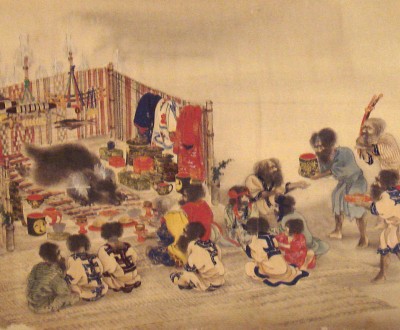The Japanese ethnic groups
While Japan loves to consider itself as a nation of "pure blood," its population is still composed of several minorities, just like any modern or developing country. These minorities contribute to Japan’s diversity, yet they remain rejected by their adopting country. Before becoming the country we know today, Japan was divided into several ethnic groups. Some of them disappeared or totally blended into other groups—we cannot even distinguish them for the current population. Others still exist today and are presented as minorities, compared to the major population: the Yamato people.
Yamato
The Yamato represent the modern Japanese population. The term 大和, created in the 4th century, marked the social and cultural differences from other ethnic groups, which were still perceived from the settlement of the Yamato people in Japan. They would have come from Asia during prehistorical eras. Today, there are still debates about whether the Yamato people, forming the vast majority of the Japanese population today, came from China and Korea, the Ainu came from Russia/Siberia and Mongolia, and the Ryukyu people came from Polynesian islands. This is not really appreciated among Japanese people, toward whom we should talk about the topic delicately.
Ever since Chinese culture arrived in Japan, quickly followed by Korean culture, there has been an idea that Japanese culture has not only come from the archipelago. We can find:
- strong inspirations in the language (Chinese writing, Korean grammar, etc.),
- Buddhist spirituality, and
- the dynastic model.
The term "Yamato" designates Japan as much it does the language. It sets the majority of Japanese apart from other groups. After first settling in Nara, Yamato people experienced a remarkable expansion and continuously pushed the Ainu north, up to Hokkaido, where they still live now.
Today, as the term "Yamato" has a strong negative and racist connotation, the famous 和 wa is widely used, with the 人 jin suffix, used for a population, when we want to distinguish Japanese-Japanese from Ainu-Japanese, or Ryukyu-Japanese.
Ainu
アイヌ Ainu people were living on the archipelago before the Yamato arrived from the southwest. Indeed, they firstly came from northern Asia, Russia, Siberia, and Mongolia. This people firstly settled everywhere in Japan. They were called Emishi (as used in Princess Mononoke) before diverse groups arrived and became scattered. While a certain mutual understanding first existed, the Emishi were eradicated by the Yamato by refusing to obey the empire being created.
Their origin and affiliation with other ethnic groups are difficult to define. They possess diverse genetic markers showing their differences from "pure" Japanese people, yet they also possess specific markers that can be found in every Japanese person. Ainu were firstly forced to stop living their culture and speaking their language, and the specificity of this group has disappeared little by little. While this oppression forced them to erase numerous social and cultural aspects, and Ainu today tend to hide their origin, Ainu culture continues and is starting to be recognized in modern Japan. Mostly farmers, fishermen or hunters, Ainu used to possess numerous rites of passage, as we can see in Mongolia. They number about 30,000 individuals and keep on trying to find recognition, so that Japan will start to know them.
This is the same story for another ethnic group on the opposite side of Japan: the Ryukyu. They used to possess their own independent kingdom. Just like the Ainu, they still exist in the extreme southern islands of Japan and are looking for recognition and rights to speak an almost extinct language.
Burakumin
There is finally another major cultural group, more a caste than an ethnic group: the 部落民 Burakumin, the "untouchables" of Japan. They are considered an "untouchable" societal caste, as they do work that nobody else wants, due to religious criteria, forbidden practices, or the degrading jobs. Here, Burakumin were untouchable as their work included handling blood, animal or human, which was forbidden by Buddhism in feudal times.
They were pushed aside by society and could not interact with the rest of Japanese people. This subject still happens to be delicate. Today, they are still outcasts of society (they represent two-thirds of the biggest yakuza families). A recently passed law forbids segregation of this minority, yet it exists through deeply anchored, hard-to-forget cultural practices. Due to this past, Burakumin still undergo discrimination today, mostly based on stereotypes, and it can be difficult for them to find a job or a place to live outside of their ghettos where they live. Even if the government tries to help them, the best for them is to blend into the majority and to change opinions and points of view from the inside.
This diversity, which is somehow not totally accepted by a timid Japan, allows one to discover the anthill under the country’s wise surface.

